Quantitative imaging of brain energy metabolisms and neuroenergetics using in vivo X-nuclear 2H, 17O and 31P MRS at ultra-high field
- PMID: 29866434
- PMCID: PMC5996770
- DOI: 10.1016/j.jmr.2018.05.005
Quantitative imaging of brain energy metabolisms and neuroenergetics using in vivo X-nuclear 2H, 17O and 31P MRS at ultra-high field
Abstract
Brain energy metabolism relies predominantly on glucose and oxygen utilization to generate biochemical energy in the form of adenosine triphosphate (ATP). ATP is essential for maintaining basal electrophysiological activities in a resting brain and supporting evoked neuronal activity under an activated state. Studying complex neuroenergetic processes in the brain requires sophisticated neuroimaging techniques enabling noninvasive and quantitative assessment of cerebral energy metabolisms and quantification of metabolic rates. Recent state-of-the-art in vivo X-nuclear MRS techniques, including 2H, 17O and 31P MRS have shown promise, especially at ultra-high fields, in the quest for understanding neuroenergetics and brain function using preclinical models and in human subjects under healthy and diseased conditions.
Keywords: Brain energy metabolism; Cerebral metabolic rate of glucose (CMR(Glc)) and oxygen (CMRO(2)) consumption, and ATP production (CMR(ATP)); In vivo X-nuclear MRS and imaging; NAD redox state; Neuroenergetics; TCA cycle rate (V(TCA)); Ultra-high magnetic field (UHF).
Copyright © 2018 Elsevier Inc. All rights reserved.
Figures
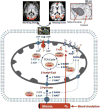

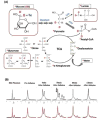

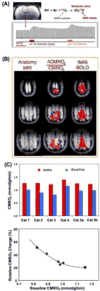

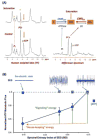

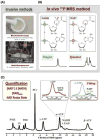
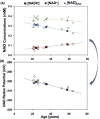
Similar articles
-
In vivo X-Nuclear MRS Imaging Methods for Quantitative Assessment of Neuroenergetic Biomarkers in Studying Brain Function and Aging.Front Aging Neurosci. 2018 Nov 27;10:394. doi: 10.3389/fnagi.2018.00394. eCollection 2018. Front Aging Neurosci. 2018. PMID: 30538629 Free PMC article.
-
Simultaneous assessment of cerebral glucose and oxygen metabolism and perfusion in rats using interleaved deuterium (2H) and oxygen-17 (17O) MRS.NMR Biomed. 2025 Jan;38(1):e5284. doi: 10.1002/nbm.5284. Epub 2024 Nov 6. NMR Biomed. 2025. PMID: 39503302 Free PMC article.
-
Brain imaging developments based on in vivo MRS.Annu Int Conf IEEE Eng Med Biol Soc. 2009;2009:50-2. doi: 10.1109/IEMBS.2009.5335032. Annu Int Conf IEEE Eng Med Biol Soc. 2009. PMID: 19965111
-
Non-invasive methods for studying brain energy metabolism: what they show and what it means.Dev Neurosci. 2000 Sep-Dec;22(5-6):418-28. doi: 10.1159/000017471. Dev Neurosci. 2000. PMID: 11111158 Review.
-
13C MRS studies of neuroenergetics and neurotransmitter cycling in humans.NMR Biomed. 2011 Oct;24(8):943-57. doi: 10.1002/nbm.1772. Epub 2011 Aug 31. NMR Biomed. 2011. PMID: 21882281 Free PMC article. Review.
Cited by
-
Dual-frequency resonant coil design for low-γ X-nuclear and proton magnetic resonance imaging at ultrahigh fields.NMR Biomed. 2023 Aug;36(8):e4930. doi: 10.1002/nbm.4930. Epub 2023 Apr 18. NMR Biomed. 2023. PMID: 36939997 Free PMC article.
-
Frequency-independent dual-tuned cable traps for multi-nuclear MRI and MRS.J Magn Reson. 2024 Nov;368:107786. doi: 10.1016/j.jmr.2024.107786. Epub 2024 Oct 10. J Magn Reson. 2024. PMID: 39413717
-
Systematic review of 31P-magnetic resonance spectroscopy studies of brain high energy phosphates and membrane phospholipids in aging and Alzheimer's disease.Front Aging Neurosci. 2023 May 18;15:1183228. doi: 10.3389/fnagi.2023.1183228. eCollection 2023. Front Aging Neurosci. 2023. PMID: 37273652 Free PMC article.
-
Chemical Hypoxia Induces Pyroptosis in Neuronal Cells by Caspase-Dependent Gasdermin Activation.Int J Mol Sci. 2024 Feb 11;25(4):2185. doi: 10.3390/ijms25042185. Int J Mol Sci. 2024. PMID: 38396860 Free PMC article.
-
Altered brain perfusion and oxygen levels relate to sleepiness and attention in post-COVID syndrome.Ann Clin Transl Neurol. 2024 Aug;11(8):2016-2029. doi: 10.1002/acn3.52121. Epub 2024 Jun 14. Ann Clin Transl Neurol. 2024. PMID: 38874398 Free PMC article.
References
-
- Siesjo BK. Brain energy metabolism. Wiley; New York: 1978.
-
- Shulman RG, Rothman DL, Behar KL, Hyder F. Energetic basis of brain activity: implications for neuroimaging. Trends Neurosci. 2004;27:489–495. - PubMed
-
- Zhu XH, Du F, Zhang N, Lu M, Zhang Y, Liu X, Lei H, Zhang XL, Ugurbil K, Chen W. Study of Brain Bioenergetics and Function using In Vivo MRS. In: Kamil Ugurbil KU, Berliner Lawrence, editors. Biological magnetic Resonance: fMRI: From Nuclear Spins to Brain Function. Springer; New York: 2015. pp. 819–864.
-
- Hyder F, Patel AB, Gjedde A, Rothman DL, Behar KL, Shulman RG. Neuronal-glial glucose oxidation and glutamatergic-GABAergic function. J Cereb Blood Flow Metab. 2006;26:865–877. - PubMed
Publication types
MeSH terms
Substances
Grants and funding
LinkOut - more resources
Full Text Sources
Other Literature Sources

